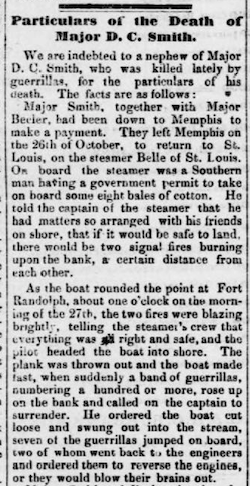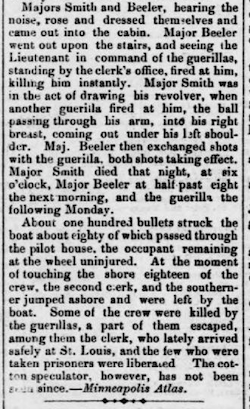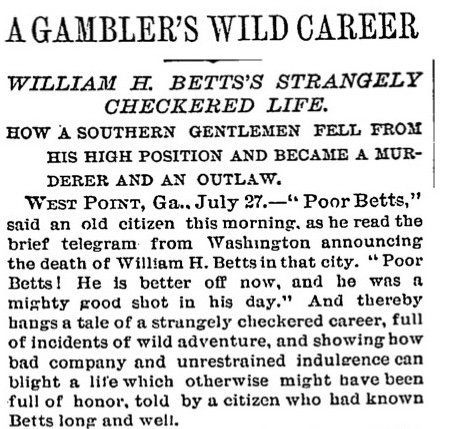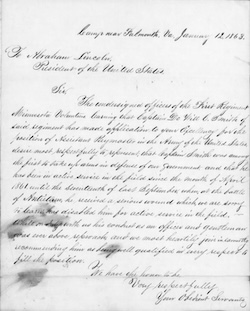Nathan Andrew Feaster (1844)
30 January 2025
Nathan Andrew Feaster was from a prominent family in the Fairfield District, SC; his father Andrew was a wealthy planter, his grandfather John reached Fairfield from Lancaster, PA sometime before 1810.
In 1844 an itinerant portrait artist named George Williamson Livermore Ladd painted several members of the Feaster family, including Nathan. He was then about 23 years old and a retail merchant in Columbia, SC, the state capital.
18 years later in May 1862, then 41, he enlisted in the First South Carolina Infantry and was appointed First Sergeant of Company F. He was wounded at Sharpsburg on 17 September 1862 and was killed by enemy fire while going to the rear for treatment.
Notes
Portrait of Nathaniel Andrew Feaster (1820–1862) by George W. L. Ladd, c. 1844. Oil on canvas; HOA: 28-3/8″, WOA: 24-1/4″. Collection of the Fairfield County Museum, Winnsboro, SC.
There’s much more about George Ladd and those Feaster portraits online from the Journal of the Museum of Early Southern Decorative Arts in Winston-Salem, NC.
A gambler’s wild career
24 January 2025
23 year old Lieutenant Colonel William H Betts, a former farmer from Tuskegee, AL, led the 13th Alabama Infantry in combat at Sharpsburg, MD on 17 September 1862 and was wounded there. His brigade and division commanders, Col. A.H. Colquitt and Maj.Gen. D.H. Hill respectively, spoke highly of him and his men.
Betts had quite a different life in peacetime after the war. He was accused of murdering at least three men in his lifetime, and acknowledged killing them. He was excused in each case as “justified.”
The first murder, according to the New York Times piece above, was of a soldier of his regiment who had somehow insulted his wife in camp at Pensacola, FL. Betts was said to have shot him on the spot (or to have stabbed him with a knife when the soldier pulled a gun). The story has at least one problem – I can find no point at which Betts and his regiment were ever in Pensacola. Perhaps it’s a mis-translation of an event at another camp in another place.
In any case, if this New York Times article is to be believed, Betts had quite an adventure in the years after the war and before his death in 1884 of kidney disease, at the relatively young age of 45 years.
Notes
See also the San Jose (CA) Daily Morning Times of 14 April 1882 and the Albany (GA) Weekly News and Advertiser of 8 April 1882, in which Betts, while testifying in someone else’s murder trial, acknowledged killing 3 men, and briefly describes the circumstances. These accounts bears only passing resemblance to the NYT story.
His death notice in the Columbus (GA) Daily Times of 1 August 1884 has him killing 6 men in his lifetime, but does have a good description of his death.
Melissa R, Eugene A, and DeWitt C Smith (1861)
8 January 2025

Here are DeWitt Clinton Smith and his family in an ambrotype photograph probably taken as he prepared to leave his home in Minnesota for the war in the east.
He’d married Melissa R. Shepard (1827-1905) in Michigan in 1847 – they were both from his hometown of Barre, NY – and their son Eugene Adelbert Smith (1850-1914) was born in Somerset, MI, where DeWitt was a Daguerrean photographer. They moved to Hennepin County, MN in 1857 and by the time the war came in 1861 he had worked as a farmer, newspaperman, shoe salesman, county land registrar, and school teacher, and was concurrently a county commissioner and postmaster.
He was commissioned 2nd Lieutenant of Company D, First Minnesota Infantry in April 1861, and was Captain of his Company when he was seriously wounded in the hip at Antietam in September 1862. The bullet lodged in his pelvis and was never removed. Disabled for further service in the field, he sought appointment as an army paymaster, a largely clerical, non-combat job. He had the support of nearly all the officers of his regiment, who sent an impressive petition to President Lincoln on his behalf in January 1863:
Nothing happened quickly, though, so in October 1863 Smith resigned his commission and returned to Minnesota.
Finally, in April 1864, an appointment as Additional Paymaster and Major, US Volunteers came through for Smith, and he went to St Louis, MO. Unfortunately, 6 months later he was killed by Confederate “guerrillas” while returning by steamboat from making Army payments in Memphis in October 1864:


Notes
The picture at the top, as Melissa R. Smith, Eugene Adelbert Smith and DeWitt Clinton Smith, family portrait, copyprint of ambrotype, may be found online from the Minnesota Historical Society.
Melissa re-married 20 years later in Minnesota – a dentist named Lent Bristol Bradley (1820-1900) who had 3 grown children of his own.
The Lincoln petition is among the Letters Received by the Adjutant General, 1861-1870 at the National Archives, online from fold3. Among the signers was Captain William F. Russell of Company L, who commanded the 2nd Company of Minnesota Sharpshooters at Antietam.
The story about his death on the Mississippi is from the St. Paul Daily Press of 10 December 1864, also online from the Minnesota Historical Society.
The other officer with Smith on the Belle was Abraham Beeler (born MD, 1822) of Illinois. He’d been First Lieutenant and Quartermaster of the 38th Illinois Infantry from August 1861 to March 1863 and was appointed Additional Paymaster and Major, US Volunteers in March 1864. There’s a fine photograph of him on his memorial; thanks to Tony Fazzini for the pointer to that.




